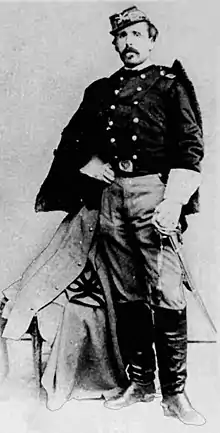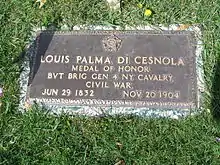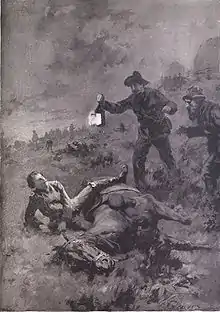Luigi Palma di Cesnola
Luigi Palma di Cesnola (July 29, 1832 – November 20, 1904), an Italian-American soldier, diplomat and amateur archaeologist, was born in Rivarolo Canavese, near Turin. He received the Medal of Honor for his actions during the American Civil War. He was United States consul at Larnaca in Cyprus (1865–1877) and first Director of the Metropolitan Museum of Art in New York (1879–1904).[1]
Luigi Palma di Cesnola | |
|---|---|
 Cesnola circa 1900 | |
| Born | July 29, 1832 Rivarolo Canavese, Italy |
| Died | November 20, 1904 (aged 72) New York City |
| Place of burial | |
| Allegiance | |
| Service/ | Union Army |
| Years of service | 1849–1854 (Sardinia) 1854–1856 (UK) 1862–1865 (USA) |
| Rank | |
| Unit | |
| Commands held | 4th New York Volunteer Cavalry Regiment |
| Battles/wars | First Italian War of Independence Crimean War American Civil War |
| Awards | Medal of Honor |
Biography
Luigi Palma di Cesnola was born the second son of a count and military officer at Rivarolo Canavese, Piedmont, in the Kingdom of Sardinia, Italy.[2] His uncle was Italian patriot Alerino Palma, and his brother was Alessandro Palma di Cesnola.[3]
In 1848 Luigi joined the Sardinian army at the age of 15, and served in the First Italian War of Independence.[3] During the battle of Novara on 23 March 1849, he was decorated for bravery and promoted to the rank of second lieutenant.[2] He graduated from the Royal Military Academy at Cherasco in 1851.[2] In 1854 he was dismissed for unknown reasons, and subsequently served with the British Army in the Crimean War as the aide-de-camp to General Enrico Fardella.[3]
In 1858 he went to New York,[2][3] where he first taught Italian and French. In February 1861 he married Mary Isabel Reid, the daughter of war hero Commodore Samuel Chester Reid.[3][4] He then founded a private military school for officers, where in six months he trained over seven hundred students.[2] Since 1862, he took part in the American Civil War as colonel of the 4th New York Cavalry Regiment, serving under the name Louis P. di Cesnola. Accused of sending stolen property North, Cesnola was threatened with dishonorable dismissal from the army.[5] However, at the Battle of Aldie (June 1863), Colonel di Cesnola was wounded and taken prisoner. He received a Medal of Honor for his efforts during the battle. He was released from Libby Prison early in 1864 when the Union Agent for Prisoner Exchange offered a personal friend of Jefferson Davis as barter.[6] He served in the Wilderness and Petersburg campaigns (1864–65) as a commander of a cavalry brigade but was not promoted to brigadier general. Although he was nominated for appointment to the brevet grade of brigadier general to rank from March 13, 1865 after the end of the war, the U.S. Senate never confirmed his appointment (contrary to the inscription on his grave stone).[7][8]


After the war, he was appointed United States consul at Larnaca in Cyprus (1865–1877). During his stay on Cyprus he carried out excavations (especially around the archaeological site of Kourion), which resulted in the discovery of a large number of antiquities. The Napried, one of the ships commissioned by di Cesnola to transport approximately 35,000 pieces of antiquities that he had collected from Cyprus, was lost at sea carrying about 5,000 pieces in its cargo.[9] The collection was purchased by the newly expanded Metropolitan Museum of Art in New York in 1872, and Cesnola became the first director in 1879, until his death in 1904. Doubt having been thrown by the art critic Clarence Cook,[10] and by Gaston L. Feuardent,[11] in an article in the New York Herald (August 1880), upon the genuineness of his restorations, the matter was referred to a special committee, which pronounced in his favor. In Cyprus however, his actions are still considered to tantamount to looting.[12] Researcher Ahmet Gazioğlu, citing excerpts from di Cesnola's own book, wrote that di Cesnola often excavated illegally using blackmail and that he was "a problem to the Turkish authorities, both because of his contempt for the law and his misbehaviour towards the officials and the people".[13]

Cesnola was the author of Cyprus, its ancient Cities, Tombs and Temples (1877), a travel book of considerable service to the practical antiquary; and of a Descriptive Atlas of the Cesnola Collection of Cypriote Antiquities (3 volumes, 1884–1886). He received honorary degrees from Columbia and Princeton universities and a special knightly order from the king of Italy,[2] and was a member of several learned societies in Europe and America.
He died in New York City on November 20, 1904.[1] He was interred at Kensico Cemetery in Valhalla, NY. His funerals, on 23 November 1904 at St. Patrick's Cathedral (Manhattan), were attended by a crowd of more than 2000 dignitaries and mourners.[14]
Medal of Honor citation

Rank and organization: Colonel, 4th New York Cavalry. Place and date: At Aldie, Va., June 17, 1863. Entered service at: New York, N.Y. Born: June 29, 1832, Rivarolo Canavese, Turin, Piedmont, Italy. Date of issue: Unknown.
At the start of the battle at Aldie, Cesnola was placed under arrest by his superior officer for protesting the promotion of a less experienced officer to brigadier general. He was stripped of his saber and sidearm. Without Cesnola the Fourth New York Cavalry balked repeatedly when asked to charge a hillside gun battery. The commanding general knew Cesnola was needed to rally the unit. He said, "Colonel, you are a brave man. You are released from arrest. Here is my own sword. Take it and bring it back to me covered in the enemy's blood."[15] When he entered the battle "the regiment arrived on the scene of conflict, and by a gallant charge, turned apparent defeat into a glorious victory for our arms, completely routing the enemy and cutting off nearly 100 men, all of whom were captured."[16] At the close of the battle Cesnola was found in a field lying under his own horse, wounded on the head by a saber and on the arm by a minie ball.[17]
See also
Notes
- "Gen. Di Cesnola Dies After Short Illness. Director of Metropolitan Museum of Art for Twenty-five Years. Made Cypriote Collection. Honored for Gallant Service in Civil War. Also Veteran of Austrian and Crimean Wars". New York Times. November 22, 1904. Retrieved 2013-12-23.
Gen. Louis Palma Di Cesnola, Director of the Metropolitan Museum of Art since 1879, died suddenly and after a very short illness on Sunday night at his residence, the Hotel Seymour, 44 West Forty-fifth Street. After his usual day's work at the museum on Friday the General attended the dinner of the Eleventh Army Corps in the evening, and left the banquet hall apparently in his usual health. ...
- Aldo E. Salerno. In The Italian American Experience: An Encyclopedia, ed. Salvatore J. LaGumina (New York: Garland, 2000), p.106
- Maria Luisa Moncassoli Tibone. "Dal Piemonte a Cipro, a New York: un’avventura appassionante".
- "Dictionary of Art Historians". Archived from the original on 2007-09-30. Retrieved 2013-11-07.
- National Archives, RG 94, Entry 297, U. S. War Department General Order No. 27, February 2, 1863
- Elizabeth, Mcfadden (1971). The Glitter and the Gold. New York: Dial Press. p. 60.
- Eicher, John H., and David J. Eicher, Civil War High Commands. Stanford: Stanford University Press, 2001. ISBN 0-8047-3641-3. p. 594
- Also, di Cesnola's name is not listed in Hunt, Roger D. and Jack R. Brown, Brevet Brigadier Generals in Blue. Gaithersburg, MD: Olde Soldier Books, Inc., 1990. ISBN 1-56013-002-4.
- "Napried Exploration". napried.com. Retrieved 2019-06-22.
- "Clarence Cook Dead", The New York Times, June 3, 1900
- "Gaston L. Feuardent," The New York Times, June 13, 1893
- Markides, Constantine (August 13, 2006). "Taking stock of our stolen past". Archaeology News. Archived from the original on January 12, 2008. Retrieved 2007-04-17.
- Gazioğlu, Ahmet C. (1990). The Turks in Cyprus: A Province of the Ottoman Empire (1571-1878). London: K. Rustem & Brother. pp. 225–230.
- Gioachino Toesca di Castellazzo, Commemorazione del generale Luigi Palma di Cesnola (Torino: Cassone, 1905)
- Beyer, Walter F. (1907). Deeds of Valor. National Archives. pp. 211–212.
- "The Fourth New York Cavalry, A Record of Its Services". The New York Times. September 25, 1864.
- Mcfadden, Elizabeth (1971). The Glitter and the Gold. New York: Dial Press.
References
- Giuseppe Giacosa, Impressioni d'America (Milano: Cogliati, 1898; 2nd ed. 1902)
- Gioachino Toesca di Castellazzo, Commemorazione del generale Luigi Palma di Cesnola (Torino: Cassone, 1905)
- Hunt, Roger D. and Jack R. Brown, Brevet Brigadier Generals in Blue. Gaithersburg, MD: Olde Soldier Books, Inc., 1990. ISBN 1-56013-002-4.
- Mcfadden, Elizabeth. The Glitter and the Gold: A Spirited Account of the Metropolitan Museum of Art's First Director, the Audacious and High-Handed Luigi Palma di Cesnola New York: Dial Press, 1971.
- Chisholm, Hugh, ed. (1911). . Encyclopædia Britannica (11th ed.). Cambridge University Press.
- Robert Cole. "A Cavalryman First." In They Made It in America (New York: Morrow, 1993) 12–15.
- Aldo E. Salerno. "Luigi Palma di Cesnola." In The Italian American Experience: An Encyclopedia, ed. Salvatore J. LaGumina (New York: Garland, 2000), p. 106
- Eicher, John H., and David J. Eicher, Civil War High Commands. Stanford: Stanford University Press, 2001. ISBN 0-8047-3641-3.
- Maria Luisa Moncassoli Tibone. "Dal Piemonte a Cipro, a New York: un’avventura appassionante". In Catalogo della mostra "Luigi Palma di Cesnola. Le gesta di un Piemontese dagli scavi di Cipro al Metropolitan Museum." – Palazzo Lascaris, 12 novembre – 11 dicembre 2004 (Torino, 2004), pp. 9–19 Online edition
- Wilson, J. G.; Fiske, J., eds. (1891). . Appletons' Cyclopædia of American Biography. New York: D. Appleton.
Further reading
- Hermary, Antoine & Mertens, Joan R. (2014). The Cesnola collection of Cypriot art: stone sculpture. New York: The Metropolitan Museum of Art. ISBN 9780300206715.
External links
- Digitized Guides to the Cesnola Collection from The Metropolitan Museum of Art Libraries
- Luigi Palma di Cesnola collection, 1861-1950s (bulk, 1861-1904) in The Metropolitan Museum of Art Archives
- The Papers of Luigi Cesnola at Dartmouth College Library
| Cultural offices | ||
|---|---|---|
| Preceded by – |
Director of the Metropolitan Museum of Art 1879–1904 |
Succeeded by Caspar Purdon Clarke |